56 results
The effect of the global language context on bilingual language control during L1 reading
-
- Journal:
- Bilingualism: Language and Cognition / Volume 28 / Issue 2 / March 2025
- Published online by Cambridge University Press:
- 16 January 2025, pp. 577-587
-
- Article
-
- You have access
- Open access
- HTML
- Export citation
Cognitive skills differentially influence narrative macrostructure in bilinguals’ L1 and L2
-
- Journal:
- Journal of Child Language , First View
- Published online by Cambridge University Press:
- 27 December 2024, pp. 1-11
-
- Article
-
- You have access
- Open access
- HTML
- Export citation
5 - Cultural Heterogeneity and Language Regime Transformation
- from Part I - Routes of Change
-
-
- Book:
- States of Language Policy
- Published online:
- 14 November 2024
- Print publication:
- 21 November 2024, pp 84-105
-
- Chapter
- Export citation

Heritage Languages
- Extending Variationist Approaches
-
- Published online:
- 09 July 2024
- Print publication:
- 27 June 2024
3 - The Toronto Context
-
- Book:
- Heritage Languages
- Published online:
- 09 July 2024
- Print publication:
- 27 June 2024, pp 29-36
-
- Chapter
- Export citation
5 - Cross-Variety Comparisons
-
- Book:
- Heritage Languages
- Published online:
- 09 July 2024
- Print publication:
- 27 June 2024, pp 92-158
-
- Chapter
- Export citation
8 - Indexicality in Heritage Languages
-
- Book:
- Heritage Languages
- Published online:
- 09 July 2024
- Print publication:
- 27 June 2024, pp 192-205
-
- Chapter
- Export citation
6 - Cross-Language Comparisons
-
- Book:
- Heritage Languages
- Published online:
- 09 July 2024
- Print publication:
- 27 June 2024, pp 159-166
-
- Chapter
- Export citation
26 - Sociolinguistic Variation in Slavic Languages
- from Part 5 - Sociolinguistic and Geographical Approaches
-
-
- Book:
- The Cambridge Handbook of Slavic Linguistics
- Published online:
- 16 May 2024
- Print publication:
- 23 May 2024, pp 559-583
-
- Chapter
- Export citation
10 - Creation and Analysis of the Multimedia Russian Corpus for Gesture Research
- from Part II - Ways of Approaching Gesture Analysis
-
-
- Book:
- The Cambridge Handbook of Gesture Studies
- Published online:
- 01 May 2024
- Print publication:
- 18 April 2024, pp 249-272
-
- Chapter
- Export citation
7 - Perception and Production of Phonemic Contrasts in Heritage Russian and Polish in Germany
-
-
- Book:
- The Phonetics and Phonology of Heritage Languages
- Published online:
- 15 February 2024
- Print publication:
- 22 February 2024, pp 147-165
-
- Chapter
- Export citation
Chapter 5 - Recognitions
-
- Book:
- Persianate Verse and the Poetics of Eastern Internationalism
- Published online:
- 14 December 2023
- Print publication:
- 21 December 2023, pp 165-196
-
- Chapter
- Export citation
12 - Parameters of variation in the syntax of expressive suffixes: Case studies of Russian, German, Spanish and Greek
- from Comparative
-
-
- Book:
- Expressivity in European Languages
- Published online:
- 24 August 2023
- Print publication:
- 07 September 2023, pp 361-392
-
- Chapter
- Export citation
Cross-linguistic influence, limited input, or working-memory limitations: The morphosyntax of agreement and concord in Heritage Russian
-
- Journal:
- Applied Psycholinguistics / Volume 44 / Issue 5 / September 2023
- Published online by Cambridge University Press:
- 05 September 2023, pp. 941-968
-
- Article
-
- You have access
- Open access
- HTML
- Export citation
On the status of NCIs: An experimental investigation on so-called Strict NC languages
-
- Journal:
- Journal of Linguistics / Volume 60 / Issue 4 / November 2024
- Published online by Cambridge University Press:
- 25 August 2023, pp. 715-755
- Print publication:
- November 2024
-
- Article
-
- You have access
- Open access
- HTML
- Export citation
7 - Case Assignment
- from Part Two - Topics in RRG: Simple Sentences
-
-
- Book:
- The Cambridge Handbook of Role and Reference Grammar
- Published online:
- 08 June 2023
- Print publication:
- 22 June 2023, pp 318-367
-
- Chapter
- Export citation
19 - Enduring Influence: Legal Categories of Displacement in the Early Twentieth Century
- from Part VI - Displaced Peoples and Refugees
-
-
- Book:
- The Cambridge History of Global Migrations
- Published online:
- 12 May 2023
- Print publication:
- 01 June 2023, pp 403-421
-
- Chapter
- Export citation
Negative Concord and locality in Russian
-
- Journal:
- Canadian Journal of Linguistics/Revue canadienne de linguistique / Volume 68 / Issue 1 / March 2023
- Published online by Cambridge University Press:
- 27 February 2023, pp. 31-73
-
- Article
-
- You have access
- HTML
- Export citation
The internal structure of the syllable in Russian and in Hebrew: Evidence from monolingual kindergarteners
-
- Journal:
- Applied Psycholinguistics / Volume 44 / Issue 1 / January 2023
- Published online by Cambridge University Press:
- 21 February 2023, pp. 101-129
-
- Article
-
- You have access
- Open access
- HTML
- Export citation
17 - Behaviorism
- from Part II - Systems of Psychology
-
- Book:
- History and Systems of Psychology
- Published online:
- 04 November 2022
- Print publication:
- 17 November 2022, pp 354-389
-
- Chapter
- Export citation


